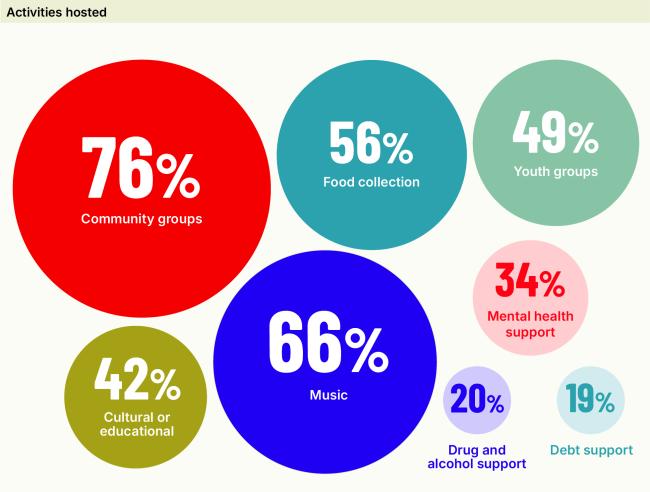
Frontline of social care
Churches are among the most accessible community buildings in the UK and their presence fosters a sense of belonging and continuity that few other local spaces can match. What makes churches distinctive is the way in which their spiritual, social, and cultural purposes come together. They remain, first and foremost, places of worship. In 2025, 80% of churches hold services at least weekly, confirming their ongoing role as spiritual centres at the heart of local life. They are sustained by volunteers who pour time and energy into keeping doors open, they provide spaces where the most vulnerable are welcomed and supported, and they house treasures that connect us to the past.
But their story does not stop at the altar: 58% are open beyond services, and 42% are open daily, offering a welcome that is rare among historic buildings. In rural areas especially, they are often the only space consistently open to and offered to all. This centre of community life is as relevant today as at any point in our history, with many churches extending their mission to include foodbanks, engagement programmes, concerts, art exhibitions and more.
Beyond worship and social gatherings, churches directly address some of the most pressing crises facing society today. The National Churches Survey shows that 56% of churches are directly involved in food distribution, with just under four in ten (37%) offering this support at least weekly. This reflects wider national trends: The Trussell Trust reported that 2.9 million emergency food parcels were distributed in the UK in 2024/2025.Many of these parcels were distributed through church-based hubs, underscoring that churches are not simply venues but the home base where frontline partners are tackling hunger.
Alongside food insecurity, churches are responding to other urgent needs. The Survey shows that 34% provide support for people struggling with anxiety, depression or isolation, and 20% run or host activities for those affected by drug or alcohol addiction. A further 19% of churches offer debt advice or support from their buildings, filling critical gaps where statutory provision is lacking or overstretched. These activities are often modest, yet their significance and impact flows precisely from being rooted in local communities – they are trusted, and accessible.
This evidence underlines a powerful truth: churches are acting as the UK’s ‘hidden welfare network’, offering support where other systems are strained. The nature of church outreach has evolved as churches have become frontline partners in health and social care.


Food and Friendship
Every Saturday at St Mary the Immaculate Conception in Lochee, Dundee, volunteers turn the church hall into a community café.
The urban church is located in one of the most deprived areas of Dundee and for many the services it offers are a lifeline. But the church itself is in poor condition. It is undergoing a multi–phase repair project, as the mid-19th century building needs a litany of repairs. When there’s heavy rainfall, water seeps into the building. The restoration is tackling everything from the roof, walls and buttresses, as well as creating disabled access.
One of the reasons why the church is undergoing so many repairs and updates is to secure the building for the future so it can continue to host and run support from the church for the most vulnerable in the community.
“We have no doubt that this restoration will have a significant impact on the wellbeing of many people. St Mary’s supports people that many others seek to exclude, not only Catholics but also people from other faiths and indeed no faith at all. People who are considered to be the most vulnerable and socially disadvantaged,” shares Gerard Fitzpatrick, a member of the Parish Restoration Team at St Mary’s Church.
